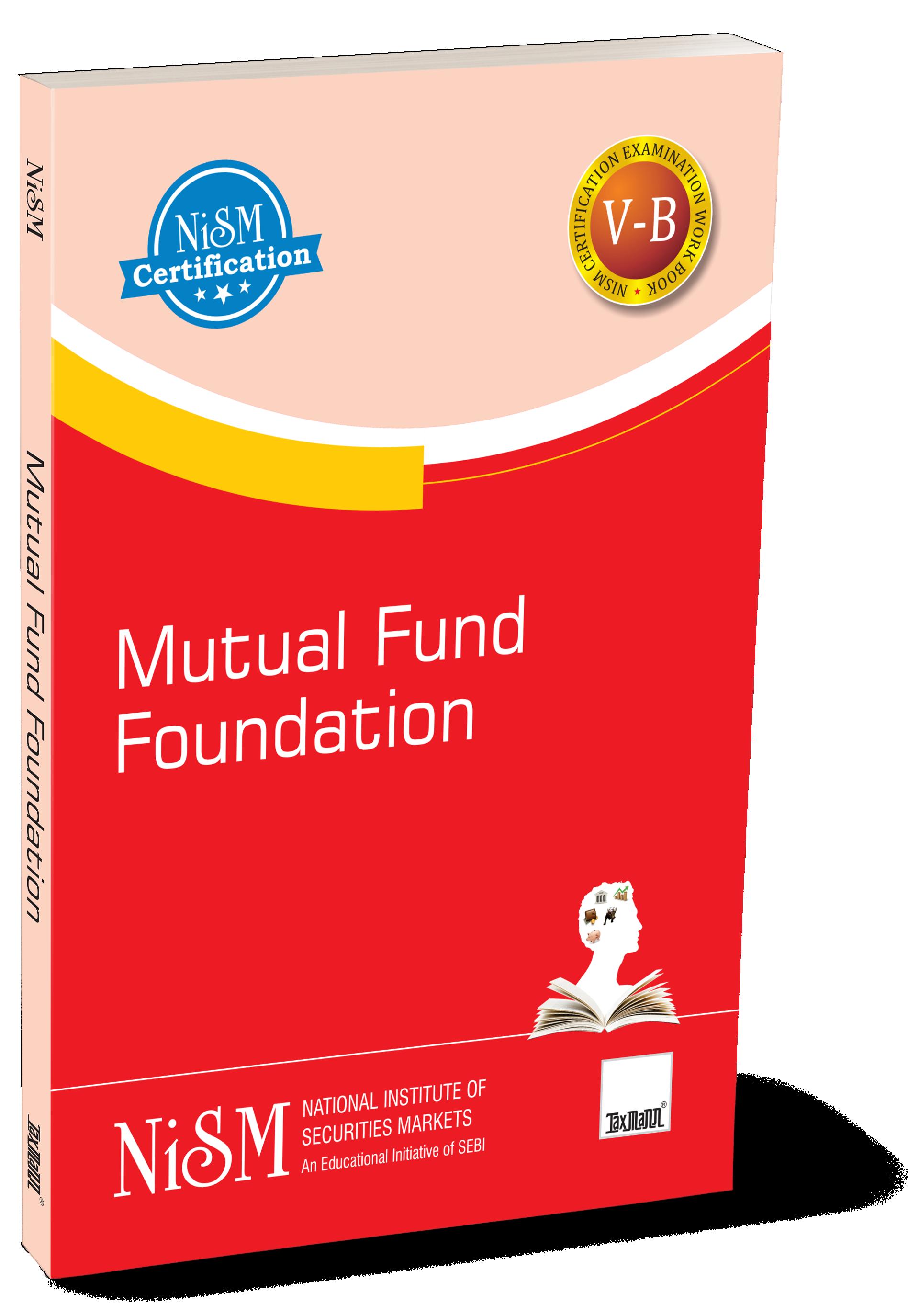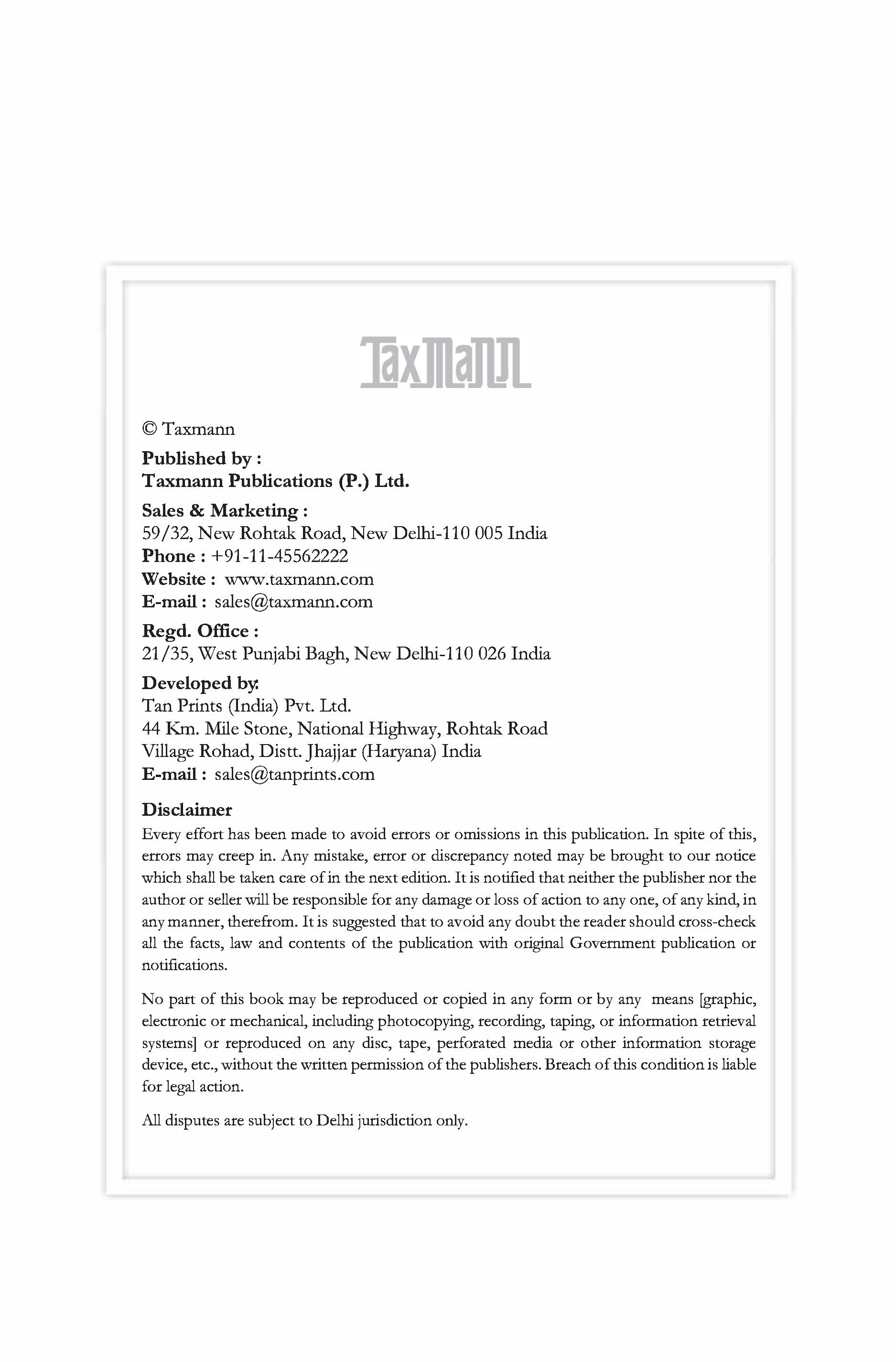







FOREWORD
NISM is a leading provider of high end professional education, certifications, training and research in financial markets. NISM engages in capacity building among stakeholders in the securities markets through professional education, financial literacy, enhancing governance standards and fostering policy research. NISM works closely with all financial sector regulators in the area of financial education. NISM Certification programs aim to enhance the quality and standards of professionals employed in various segments of the financial services sector. NISM’s School for Certification of Intermediaries (SCI) develops and conducts certification examinations and Continuing Professional Education (CPE) programs that aim to ensure that professionals meet the defined minimum common knowledge benchmark for various critical market functions.
NISM certification examinations and educational programs cater to different segments of intermediaries focusing on varied product lines and functional areas. NISM Certifications have established knowledge benchmarks for various market products and functions such as Equities, Mutual Funds, Derivatives, Compliance, Operations, Advisory and Research.
NISM certification examinations and training programs provide a structured learning plan and career path to students and job aspirants who wish to make a professional career in the Securities markets. Till March 2023, NISM has issued more than 17 lakh certificates through its Certification Examinations and CPE Programs. NISM supports candidates by providing lucid and focused workbooks that assist them in understanding the subject and preparing for NISM Examinations. The book covers all important topics to enhance the quality of sales, distribution and related support services in the mutual fund industry. It covers topics related to the basics of mutual funds, their role and structure, different kinds of mutual fund schemes and their features, accounting, valuation and taxation aspects underlying
I-3

FOREWORD
mutual funds and their distribution. This course teaches financial planning as an approach to investing in mutual funds, and an aid for advisors to develop long term relationships with their clients. The book also discusses the concept of scheme evaluation, recommendation of suitable products and services to investors and prospective investors. It will be immensely useful to all those who want to have a better understanding of Indian mutual fund industry.
I-4
Dr. C.K.G Nair Director

ACKNOWLEDGEMENT
This workbook has been developed jointly by the Certification Team of National Institute of Securities Markets (NISM), NISM Resource Persons—Mr. Sundar Sankaran, Ms. Sunita Abraham and Mr. Amit Trivedi. NISM gratefully acknowledges the contribution of the Examination Committee for NISM-Series-V-B: Mutual Fund Foundation Certification Examination consisting of industry experts.
I-5

ABOUT NISM CERTIFICATIONS
The School for Certification of Intermediaries (SCI) at NISM is engaged in developing and administering Certification Examinations and Continuing Professional Education (CPE) Programs for professionals employed in various segments of the Indian securities markets.
These Certifications and CPE Programs are being developed and administered by NISM as mandated under Securities and Exchange Board of India (Certification of Associated Persons in the Securities Markets) Regulations, 2007.
The skills, expertise and ethics of professionals in the securities markets are crucial in providing effective intermediation to investors and in increasing the investor confidence in market systems and processes. The School for Certification of Intermediaries (SCI) seeks to ensure that market intermediaries meet defined minimum common benchmark of required functional knowledge through Certification Examinations and CPE Programs on Mutual Funds, Equities, Derivatives, Securities Operations, Compliance, Research Analysis, Investment Advice and many more.
Certification creates quality market professionals and catalyzes greater investor participation in the markets. Certification also provides structured career paths to students and job aspirants in the securities markets.
I-7

ABOUT THE CERTIFICATION EXAMINATION FOR MUTUAL FUND FOUNDATION
EXAMINATION OBJECTIVES
On successful completion of the examination the candidate should:
Know the basics of mutual funds, their role and structure, different kinds of mutual fund schemes and their features.
Know how mutual funds are distributed in the market-place, how specified schemes are to be evaluated and how suitable schemes can be recommended by this cadre of distributors to prospective investors.
Know the rules and regulations related to distribution of specified products.
ASSESSMENT STRUCTURE
The examination consists of 50 questions of 1 mark each and should be completed in 2 hours. The passing score on the examination is 50%. There shall be no negative marking.
HOW TO REGISTER AND TAKE THE EXAMINATION
To find out more and register for the examination please visit www.nism.ac.in
I-9

ABOUT THE CERTIFICATION EXAMINATION FOR MFF
IMPORTANT
Please note that the Test Centre workstations are equipped with either Microsoft Excel or Openoffice Calc. Therefore, candidates are advised to be well versed with both of these softwares for computation of numericals.
I-10

I-11 CONTENTS PAGE ForewordI-3 AcknowledgementI-5 AboutNISMCertificationsI-7 AbouttheCertificationExaminationforMutualFundFoundationI-9 SyllabusOutlinewithWeightagesI-15 CHAPTER 1 INVESTMENT LANDSCAPE 1.1 Saving or Investments? 1 1.2 Different Asset Classes 3 1.3 Four Broad Financial Needs 9 1.4 Different Types of Financial Goals 10 1.5 Role of Mutual Funds in Achieving Different Financial Goals 12 CHAPTER 2 CONCEPT AND ROLE OF A MUTUAL FUND 2.1 Concept of a Mutual Fund 17 2.2 Classification of Mutual Funds 27 2.3 Growth of the Mutual Fund Industry in India 40

I-12 CONTENTS PAGE CHAPTER 3 LEGAL STRUCTURE OF MUTUAL FUNDS IN INDIA 3.1 Structure of Mutual Funds in India 43 3.2 Key Constituents of a Mutual Fund 45 3.3 Organization Structure of Asset Management Company 49 3.4 Role and Support Function of Service Providers 52 3.5 Role and Function of AMFI 56 CHAPTER 4 MUTUAL FUND PRODUCTS FOR THE NEW CADRE OF DISTRIBUTORS 4.1 Introduction to Mutual Fund Products for New Cadre of Distributors 59 4.2 Liquid Schemes/Money Market Schemes 60 4.3 Index Funds 61 4.4 Diversified Equity Schemes 63 4.5 Retirement Benefit Schemes 64 4.6 Fixed Maturity Plans (FMPs) 65 CHAPTER 5 SCHEME RELATED INFORMATION 5.1 Mandatory Documents 67 5.2 Non-Mandatory Disclosures 77 CHAPTER 6 FUND DISTRIBUTION AND CHANNEL MANAGEMENT PRACTICES 6.1 The Role and Importance of Mutual Fund Distributors 81 6.2 Different Kinds of Mutual Fund Distributors 82

I-13 CONTENTS PAGE 6.3 Modes of Distribution 84 6.4 Pre-requisites to become Distributor of a Mutual Fund 88 6.5 Revenue for a Mutual Fund Distributor 92 6.6 Commission Disclosure Mandated by SEBI 99 6.7 Due Diligence Process by AMCs for Distributors of Mutual Funds 100 6.8 Difference between Distributors and Investment Advisors 101 6.9 Nomination Facilities to Agents/Distributors and Payment of Commission to Nominee 104 6.10 Change of Distributor 106 CHAPTER 7 PERFORMANCE OF MUTUAL FUNDS 7.1 Calculation of Returns of Mutual Fund Schemes 109 7.2 Concept of Loads and Application of Exit Load in Calculating Transaction Price 112 7.3 Concept of Risk in a Mutual Fund Investment 113 7.4 Concept of Risk-adjusted Return 124 7.5 Scheme Benchmarks for Mutual Fund Schemes 126 CHAPTER 8 TAXATION 8.1 Applicability of Taxes in Respect of Mutual Funds 132 8.2 Capital Gains 133 8.3 Dividend Income (IDCW option) 137 8.4 Stamp Duty on Mutual Fund Units 139 8.5 Setting off of Capital Gains and Losses under Income-tax Act 140 8.6 Securities Transaction Tax 141 8.7 Tax Benefit under Section 80C of the Income-tax Act 141 8.8 Tax Deducted at Source 143 8.9 Applicability of GST 143

I-14 CONTENTS PAGE CHAPTER 9 INVESTOR SERVICES 9.1 The NFO Process 146 9.2 New Fund Offer Price/On-going Offer Price for Subscription 147 9.3 Investment Plans and Services 147 9.4 Allotment of Units to the Investor 151 9.5 Account Statements for Investments 152 9.6 Mutual Fund Investors 153 9.7 Filling the Application Form for Mutual Funds 155 9.8 Financial Transactions with Mutual Funds 160 9.9 Cut-off Time and Time Stamping 172 9.10 KYC Requirements for Mutual Fund Investors 176 9.11 Systematic Transactions 186 9.12 Operational Aspects of Systematic Transactions 190 9.13 Non-Financial Transactions in Mutual Funds 194 9.14 Change in Status of Special Investor Categories 201 9.15 Investor Transactions – Turnaround Times 205 CHAPTER 10 LEGAL AND REGULATORY ENVIRONMENT 10.1 Role of Securities and Exchange Board of India 209 10.2 Investor Grievance Redressal 223 10.3 AMFI Code of Conduct for Intermediaries 225 Appendix 1: Format of Scheme of Information Document (SID) 227 Appendix 2: Format of Statement of Additional Information (SAI) 246 Appendix 3: Format of Key Information Memorandum 255 Appendix 4: AMFI Code of Ethics 260 Appendix 5: AMFI’s Code of Conduct for Intermediaries of Mutual Funds 266

SYLLABUS OUTLINE WITH WEIGHTAGES
UnitsChapter
1 Investment Landscape6%
2 Concept and Role of a mutual fund12%
3 Legal Structure of mutual funds8%
4 Mutual fund products for the new cadre of distributors6%
5 Scheme Related Information12%
6 Fund Distribution and Channel Management Practices10%
7 Performance of Mutual Funds12%
8 Mutual fund Taxation6%
9 Investor Services20%
10 Legal and Regulatory Environment8%
Total Weightage100%
I-15
titleWeightage (%)


CHAPTER 4
MUTUAL FUND PRODUCTS FOR THE NEW CADRE OF DISTRIBUTORS
LEARNING OBJECTIVES:
After studying this chapter, you should understand about:
Liquid schemes/money market schemes
Index Funds
Diversified Equity Schemes
Retirement Benefit Schemes
Fixed Maturity Plans (FMPs)
4.1 Introduction to Mutual Fund Products for New Cadre of Distributors
Chapter 2 discussed various types of mutual funds and the scheme categorization as per the SEBI circular. This chapter deals with the specific products allowed to be distributed by the basic cadre of distributors13.
As per the circular, the following may be considered to be empanelled as mutual fund distributors under the new cadre:
1. Postal agents,
2. Retired government and semi-government officials (class III and above or equivalent) with a service of at least 10 years,
13 SEBI circular CIR/IMD/DF/21/2012 dated September 13, 2012.
59

3. Retired bank officers with a service of at least 10 years, and
4. Other similar persons (such as bank correspondents) as may be notified by AMFI/AMC from time to time
These new cadre distributors can sell only simple and performing schemes. Such products include:
1. Liquid/money market schemes
2. Index schemes
3. Diversified equity schemes
4. Retirement benefit schemes having tax benefits
5. Fixed Maturity Plans (FMPs)
These products should have returns equal to or better than their scheme benchmark returns during each of the last three years.
This chapter would discuss each of these schemes in detail.
4.2 Liquid Schemes/Money Market Schemes
A Liquid Fund is an open-ended liquid scheme whose investment is into debt and money market securities with maturity of upto 91 days only.
A Money Market Fund is an open-ended debt scheme investing in money market instruments having maturity upto 1 year.
Both the above categories of funds invest in debt and money market securities, with very short maturities. As mentioned above, while money market funds can invest in money market securities that mature in less than a year; liquid funds can invest in debt and money market securities maturing within 91 days. This means the interest rate risk14 is very low in both these funds. Money market securities also have high credit rating, and hence the credit risk15 is very low. These funds are considered to be among the lowest risk funds within mutual funds.
Low interest rate risk coupled with low credit risk makes these funds suitable for short term parking of surplus money. Many mutual fund distributors recommend
14 Interest rate risk is the sensitivity of debt securities with respect to movement of interest rates within the economy. When the interest rates move up, prices of debt papers move down, and viceversa
15 Refer to Chapter 7 for further details on this risk.
60
FUND
NEW
MUTUAL
PRODUCTS FOR THE
CADRE OF DISTRIBUTORS
MUTUAL FUND
PRODUCTS
FOR THE NEW CADRE OF DISTRIBUTORS

these funds to their investors when the surplus is available for short, but uncertain periods.
Many also use these funds for another purpose. They park the customer’s surplus funds in liquid or money market funds, and then periodically transfer the same in equity funds on a regular basis – a process known as Systematic Transfer Plan (STP).
4.3 Index Funds
An Index Fund is an open-ended scheme replicating/tracking a specific index. The minimum investment in securities of a particular index (which is being replicated/ tracked) shall be 95 percent of total assets. In other words, at least 95 percent of the assets of the scheme must be invested in the constituents of the index.
In order to understand an index fund, it is important to know what an index is. A stock market index is created by selecting a group of stocks that are representative of the whole market or a specified sector or segment of the market. An Index is calculated with reference to a base period and a base index value. An Index is used to give information about the price movements of products in the financial, commodities or any other markets. Financial indexes are constructed to measure price movements of stocks, bonds, T-bills and other forms of investments. Stock market indexes are meant to capture the overall behaviour of equity markets16.
As mentioned in the definition above, it is a representative of the entire market, or a specified segment of the same. It is also known as the barometer of the respective market. When the value of the index moves up, the market is considered have moved up, and viceversa. Looking at it in another way, observers look at the index movement to check whether the market is up or down.
There are indices to track various markets, across asset categories. Here is a list of some of the indices available in the various markets:
S&P BSE Sensex is an index representing stocks of 30 large companies listed on the BSE Ltd.
NIFTY 50 is an index that represents stocks of 50 large companies listed on the National Stock Exchange. 16 Source: www.nseindia.com
61

MUTUAL FUND PRODUCTS FOR THE NEW CADRE OF DISTRIBUTORS
NIFTY SmallCap 250 is an index that represents stocks of 250 small companies listed on the National Stock Exchange.
CRISIL Liquid Fund Index is an index that seeks to track the performance of liquid funds – essentially representing liquid funds.
I-Sec Li-Bex is an index representing Government bonds with long term maturity (of more than 7 years).
Russell 3000 index is an index representing 3000 stocks listed in the US stock markets
Nifty Bank Index is an index that comprises of the most liquid and large Indian banks.
An index fund is a mutual fund that replicates an index. Thus, an index fund becomes the simplest product for an investor seeking to take an exposure to a market or a segment thereof. Someone who wants to invest in large companies in India can simply buy an index fund tracking S&P BSE Sensex or Nifty. Similarly, one can take exposure to the smallcap segment of the market by buying Nifty Smallcap 250 index fund (assuming that such a fund is available). As we can also see from the above examples, there are indices available on sectors, and hence there could be funds available that track such indices. There could also be mutual funds investing in foreign stocks, or even debt papers and government securities.
An index fund is also called a passive fund, since the fund manager need not be actively manage the portfolio, which only mirrors the composition of the underlying index. The role of the fund management team is only to manage the inflows into and outflows from the fund on account of purchases and redemptions; and ensure that the portfolio tracks the respective index. In other words, the fund manager does not need to decide which securities to buy or sell and when to do so.
Due to a very limited role of the fund management team, the total expense ratio (TER)17 in case of index funds is very low. SEBI has also allowed a lower limit of the maximum expenses that could be charged.
Given such characteristics of the index funds, they make a good choice for many investors:
As already mentioned, it is the simplest way to take exposure to any market.
17 See Section 2.2.3 for the discussion on Total Expense Ratio.
62
MUTUAL FUND PRODUCTS FOR THE NEW CADRE OF DISTRIBUTORS

For those seeking wealth creation, but are not sure which schemes to choose, equity-oriented index funds could be an ideal choice.
For those seeking to invest overseas, but do not possess enough skills to conduct research on foreign stocks, an index fund tracking the respective foreign market is an excellent choice.
Since the index fund tracks the underlying index, it becomes easy for an investor to understand and track the performance of the scheme. Currently in India, we have index funds available on equity indices, and majority of these are tracking the large-cap indices, viz., Nifty and Sensex.
4.4 Diversified Equity Schemes
Equity as an asset class has the potential to generate returns higher than inflation. When that happens, the purchasing power of one’s money grows. In other words, one’s wealth increases when the investment yields higher returns than inflation. At the same time, equity is a risky asset in that the share prices fluctuate a lot. Due to such fluctuations, there is a high possibility that one may end up buying at high prices or selling at low prices or both.
There is also a risk involved in equity investing. When an investor invests in a company’s share, there is a possibility that the company does very well, and the share price moves up over the years. At the same time, if the company struggles or incurs losses or fails altogether, the shareholder loses. The loss could be as much as the entire capital invested.
While investors would want to invest in such an asset category, but would also like to reduce the risk as much as possible.
The risks highlighted above can be mitigated through two things:
By investing in a diversified portfolio made up of stocks of good quality companies in sound businesses, and
By staying invested for long term through ups and downs of the markets
The first can be easily achieved through investing in a diversified equity mutual fund, and once that is done, one only needs to stay invested in the mutual fund scheme, or to keep adding to the investment periodically as and when one’s savings permit. For a large number of investors, SIP (Systematic Investment Plan) helps here.
63

MUTUAL FUND PRODUCTS FOR THE NEW CADRE OF DISTRIBUTORS
A diversified equity fund is a simple type of mutual fund that invests across a wide spectrum of companies representing a number of industrial sector. Such diversification reduces the risk of owning one company’s share or the risk of owning shares of companies from one industry.
Care must be taken by the distributor to see the segment of the market that such a fund is investing in – is it investing in stocks of large companies, or mid-sized companies, or small companies, or a combination of these? The large companies are generally less risky in comparison to their smaller counterparts. At the same time, these small companies also offer higher return potential. Care must be taken to understand this while selecting the schemes for the investors.
4.5 Retirement Benefit Schemes
Retirement Fund: An open-ended retirement solution-oriented scheme having a lock-in of 5 years or till retirement age (whichever is earlier). Scheme having a lock-in for at least 5 years or till retirement age whichever is earlier. The retirement benefit schemes are meant for creating a retirement corpus that can generate income to fund the lifestyle after one retires from work.
Most fund houses offer more than one options under this category to satisfy the needs of different categories of investors, depending on their risk-taking ability. For those who can afford to take high risks, there are plans that allocate more money to equity assets, whereas for the conservative investors, the fund houses offer plans with higher allocation to debt (which means lower allocation to equity).
These schemes come with a lock-in of 5 years, and offer tax benefit under Section 80C of the Income Tax Act.
Depending on the type of scheme, the investment would be predominantly between equity and debt securities. The scheme could be named an aggressive fund, or an equity fund that would invest predominantly in equity shares; however, the moderate or conservative plans (some fund houses call these equity hybrid plans and debt hybrid plans).
Resident Indians, Non-Resident Indians (NRIs), and Persons of Indian Origin (PIOs) are eligible to invest in the retirement benefit schemes only if they are of 18 years and above.
64
MUTUAL FUND PRODUCTS FOR THE NEW CADRE OF DISTRIBUTORS
4.6 Fixed Maturity Plans (FMPs)

Fixed maturity plans are a kind of close-ended debt fund where the duration of the investment portfolio is closely aligned to the maturity of the scheme. AMCs tend to structure the scheme around pre-identified investments. Further, being close-ended schemes, they do not accept money post-NFO. Therefore, the fund manager has little ongoing role in deciding on the investment options. Such a portfolio construction gives more clarity to investors on the likely returns if they stay invested in the scheme until its maturity (though there can be no guarantee or assurance of such returns). This helps them compare the risk and returns of the scheme with alternative investments.
As already mentioned, the big benefit of such schemes is that it is relatively easy to estimate the returns expected from such schemes. At the same time, these are close-ended funds and hence no redemption is allowed before the scheme’s maturity. On maturity of the scheme, the investors’ money is returned. In order to provide liquidity to the investors, listing of the units of such schemes on recognized stock exchanges is compulsory. However, such listing does not guarantee liquidity, as the trading volumes in these units may be very low, or there may be no trading at all.
The Asset Management Companies (AMCs) are required to publish a list of such simple and performing schemes on their websites to enable to new cadre of distributors to distribute these schemes to their clients.
Drivers of returns
In the liquid and money market funds, the major driver of the scheme returns would be the yield earned from the debt instruments. Similarly, in case of FMPs too, the returns would come from the yield on the debt securities.
The diversified equity funds and the index funds would derive the returns from the returns generated by the portfolio of stocks the scheme has invested in.
The returns from the retirement funds would depend on how the money is allocated between equity and debt.
65

MUTUAL FUND PRODUCTS FOR THE NEW CADRE OF DISTRIBUTORS
Chapter 4: Sample Questions
1. Which of the following scheme categories is permitted to be distributed by the new cadre of distributors?
(a) All Government Securities Schemes
(b) Index schemes
(c) Credit Risk Schemes
(d) Arbitrage Schemes
2. Which of the following would be close-ended mutual fund scheme?
(
a) Fixed Maturity Plans (FMPs)
(
b) Index Schemes
(c) Diversified Equity Schemes
(d) Retirement Benefit Schemes
3. Which among the following schemes is most likely to have a lock-in period of at least 5 years?
(a) Fixed Maturity Plans (FMPs)
(b) Index Schemes
(c) Diversified Equity Schemes
(d) Retirement Benefit Schemes
4. Which of the following schemes would not invest in equity shares of companies?
(a) Index funds
(b) Diversified equity funds
(c) Money market funds
(d) Retirement benefit schemes
66
Mutual Fund Foundation
AUTHOR : NISM
PUBLISHER : TAXMANN
DATE OF PUBLICATION : JANUARY 2024
EDITION : WORKBOOK VERSION - OCTOBER 2023
ISBN NO : 9789357786027
NO. OF PAGES : 288
BINDING TYPE : PAPERBACK


Rs. 430
Description
The book is a comprehensive guide on sales, distribution, and support services in the mutual fund industry.
It covers mutual funds’ basics, roles, structures, types, accounting, valuation, taxation, and distribution
Designed specifically to aid financial advisors, the book emphasizes understanding mutual funds and using this knowledge to develop and maintain client relationships. It will also benefit all those who want to understand the Indian mutual fund industry better. This book also advocates for financial planning as a key investment approach in mutual funds. It discusses the concept of:
Scheme Evaluation – It discusses how to evaluate various mutual fund schemes.
Recommendation of Products and Services – Guidance is provided on recommending suitable products and services to investors and prospective investors.
The Present Publication is the October 2023 workbook version, published exclusively by Taxmann for NISM Certification Examination V-B [Mutual Fund Foundation], with the following noteworthy features:
[ Know the Basics ] A section that provides an in-depth understanding of mutual funds, including their roles, structures, and different types of schemes.
[ Know How Mutual Funds are Distributed ] This part discusses the distribution of mutual funds in the market, including evaluating schemes and recommending suitable schemes to prospective investors.
[ Know the Rules and Regulations ] It covers the regulatory framework related to distributing mutual fund products, an important aspect for professionals in the industry.
ORDER NOW













